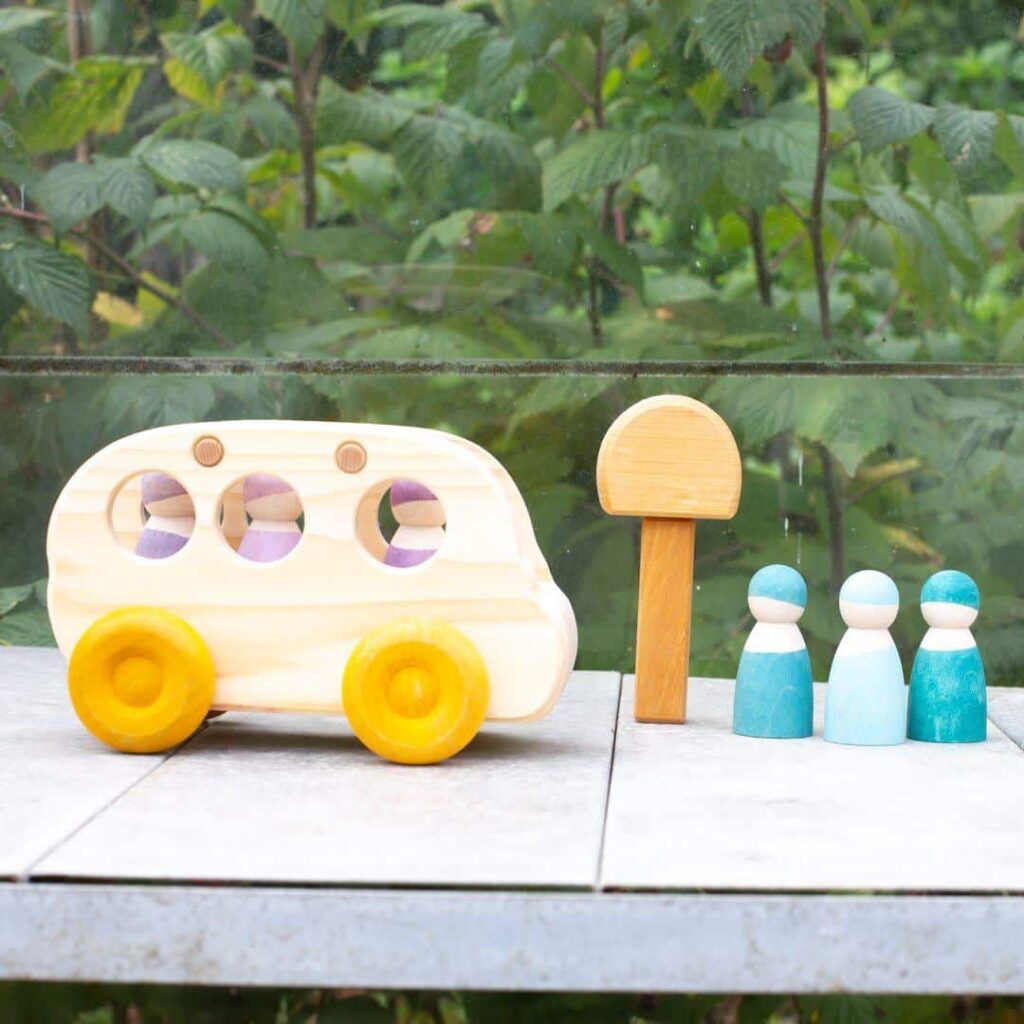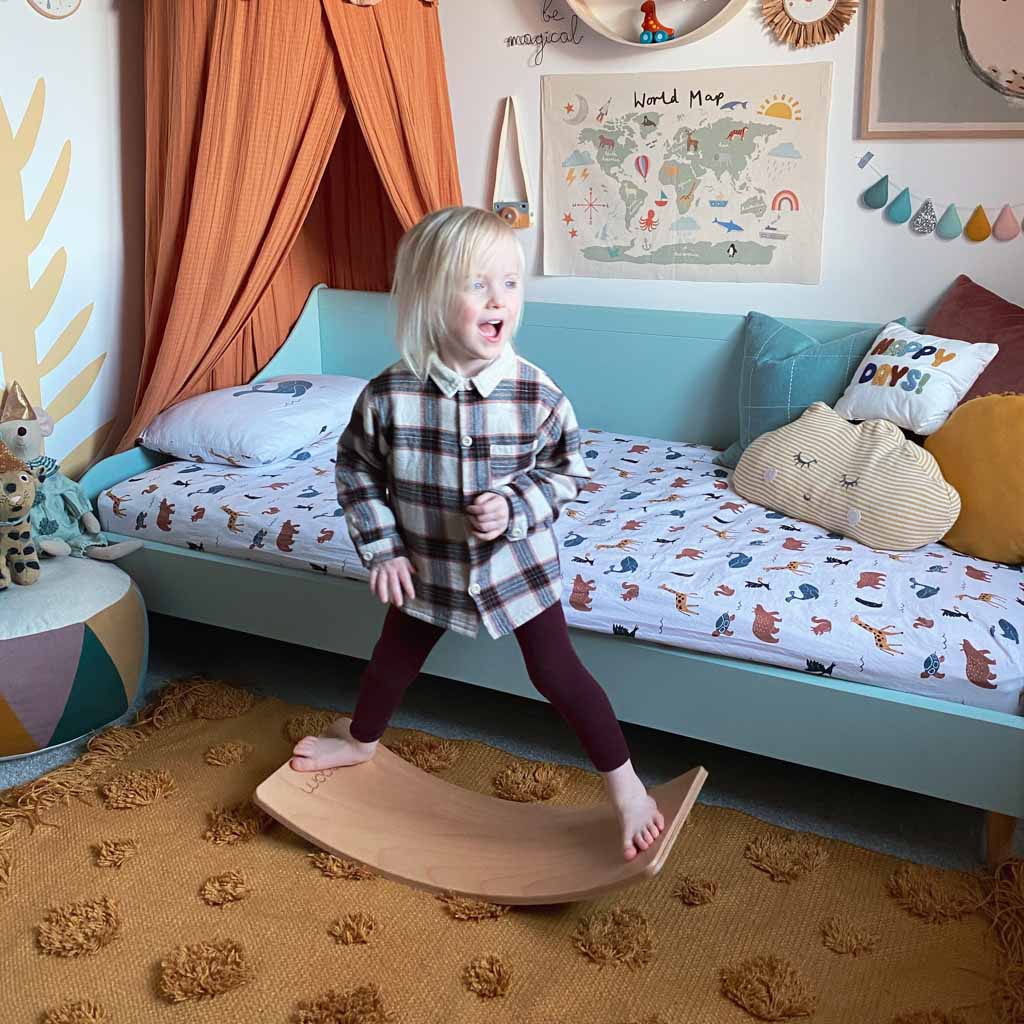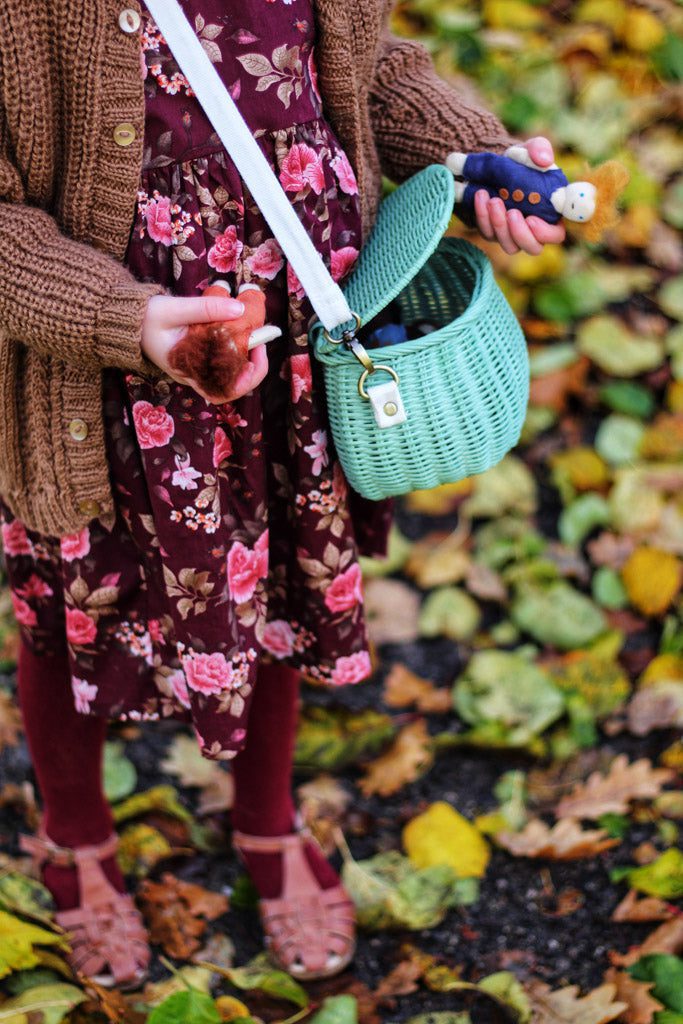There’s something about Grimm’s toys that makes them look educational. But what is it?
It’s not the rainbow colours. It’s not the tactile wood.
In this Grimm’s Rainbow review, we’ll look at the secret hidden inside these beautiful toys.
Even if you have a rainbow – or don’t want one – read on. We’re taking a look at how children learn and some fun and free ways to get the same play from things you already have at home.
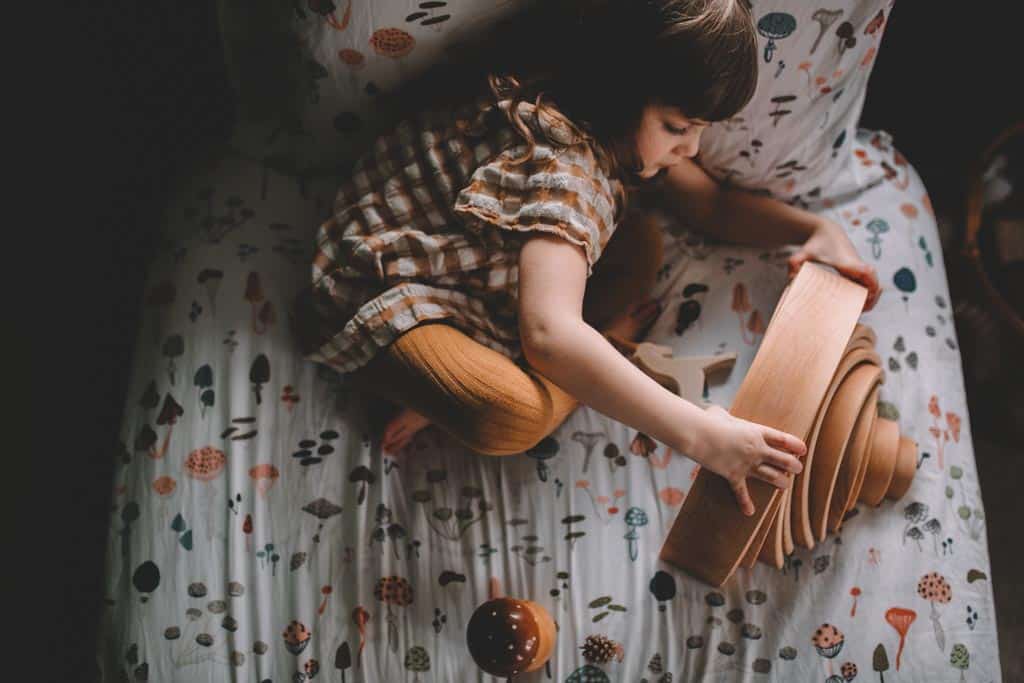
Seriation
Learning to put things in order – seriation – is a major stepping stone on the early learning journey.
Daddy Bear, Mummy Bear and Baby Bear.
1, 2, 3, 4, 5, once I caught a fish alive.
Before maths, before writing, comes one more, one less, before and after; bigger, smaller; next to, inside and out.
You can’t play football until you can stand or walk, kick or tackle. You can’t spell a word until you know how to order the letters.
To put things into series, we have to be able to compare them. That is, we must be able to put them side by side and identify difference. This sounds easy but give a 10-month-old a conical stacker and see how far she gets.
Children start by learning to compare two objects. This one is bigger, this one is smaller.
The next challenge is to arrange three objects. Which one goes in the middle? Three billy goats, big, medium-sized and small.
And it’s not just lining things up. Nesting, or fitting inside, also involves seriation.
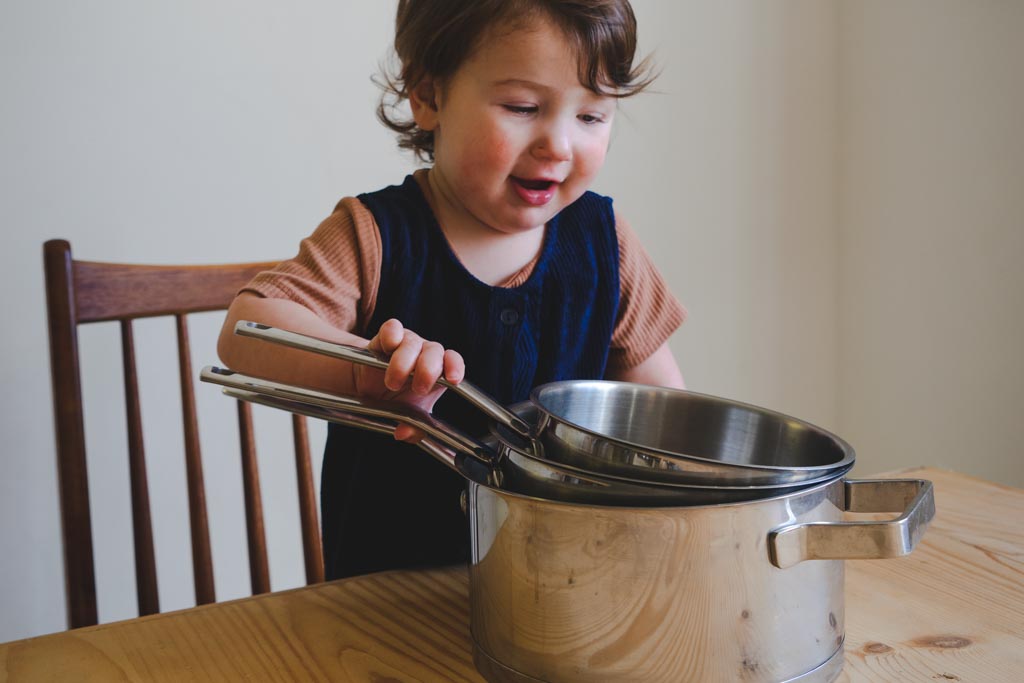
As you extend your series, mistakes can creep in. The small pan fits into the big pan but if you forget the medium-sized one, you can’t put it in at the end.
This is because younger children are simply comparing one piece to its neighbour rather than looking at the series as a whole.
Fortunately, the answer is built in to the rainbow.
Rainbows are didactic
The great thing about seriation is that when everything is in order, it looks right. These are didactic materials They teach us. There’s a right way to arrange them and it’s obvious when we have succeeded.
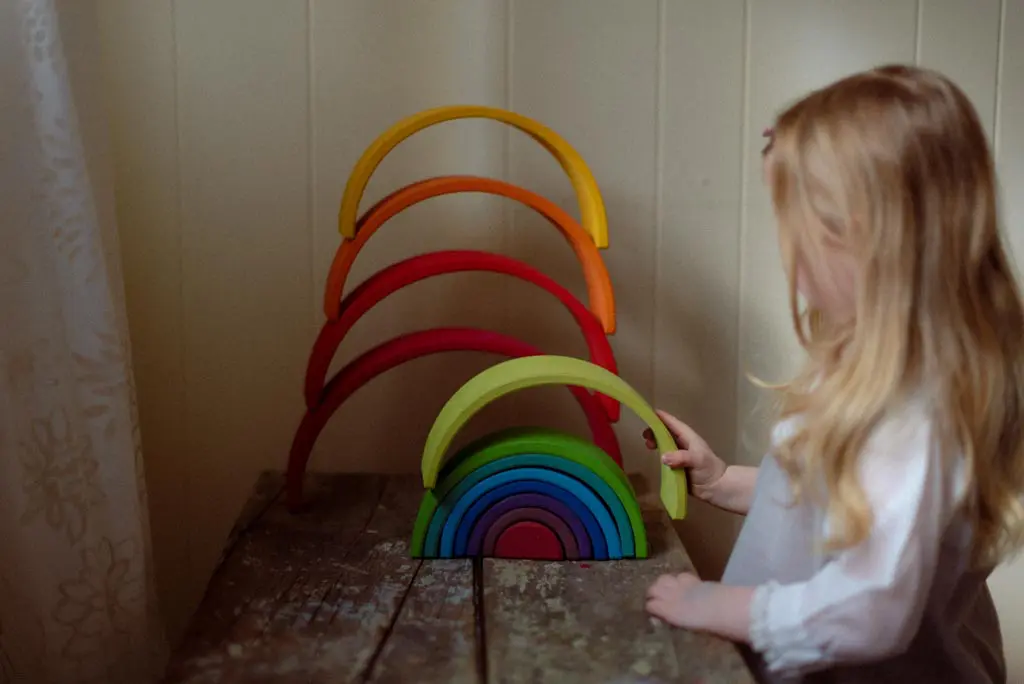
That means Grimm’s Rainbows are great for independent play. They meet your child where she is, at her current level of understanding. She doesn’t need your help. She can work everything out for herself.
Over, under and through
Why are toddlers obsessed with wooden train sets?
My eldest would play with his railway for hours. Friends and family saw that he ‘liked’ Thomas the Tank Engine so for a couple of years, every birthday and Christmas they gave him more trains for his collection.
But if they’d taken a moment to observe him play they would have noticed that it wasn’t the trains he was interested in.
He liked the tunnels.
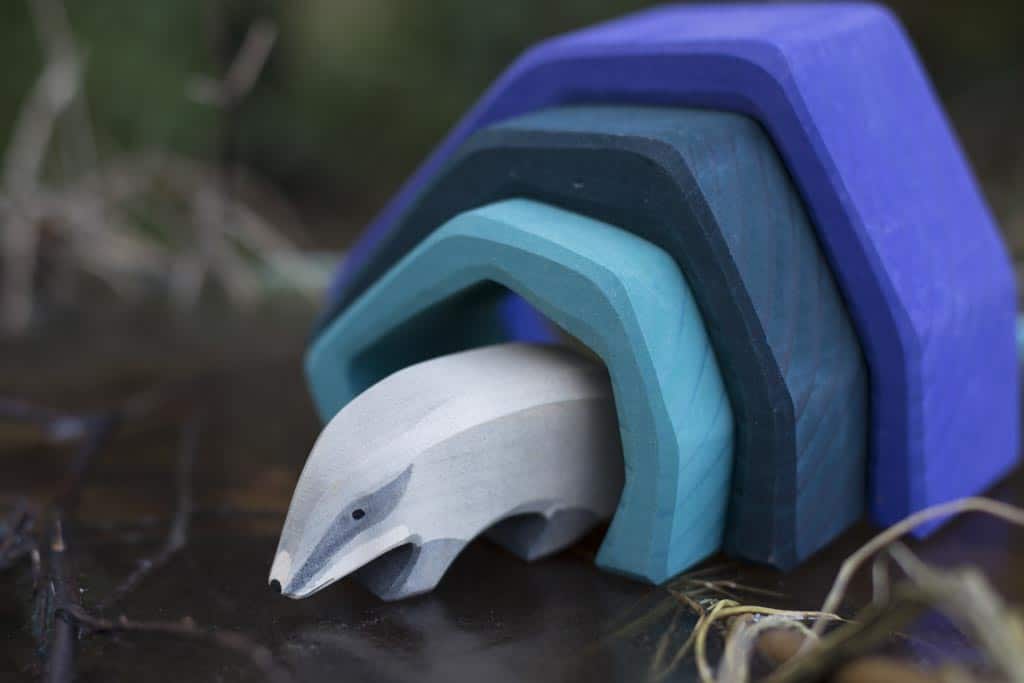
Toddlers try to make sense of the world by making mental models of concepts and forms. We call these representations schemas.
There are all kinds of schemas. Some are for actions and some are for forms, or arrangements.
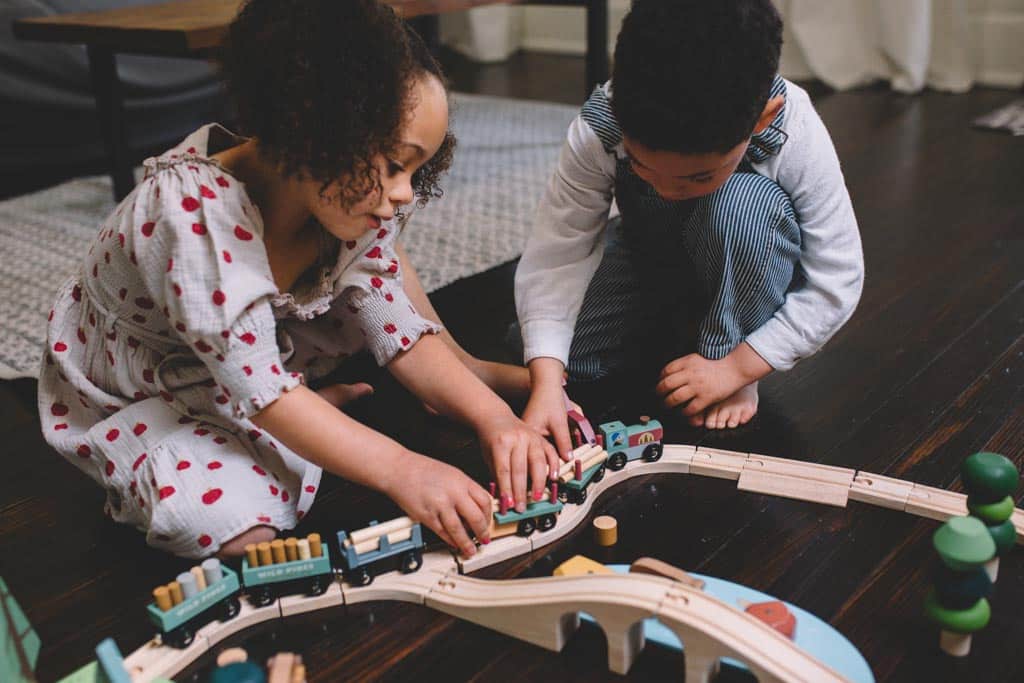
Here we are talking about the enveloping schema.
When you played peek-a-boo with your baby, she squealed with delight whenever you reappeared. That’s because she didn’t yet understand object permanence, the idea that hidden things still exist.
This is how the idea of enveloping begins.
Toddlers continue to explore this concept, posting toys into boxes. It’s exciting to close the lid and then open it again to see what’s inside. It’s even better if you post Daddy’s keys down the back of the radiator. Will they drop out at the bottom or disappear forever? What fun!
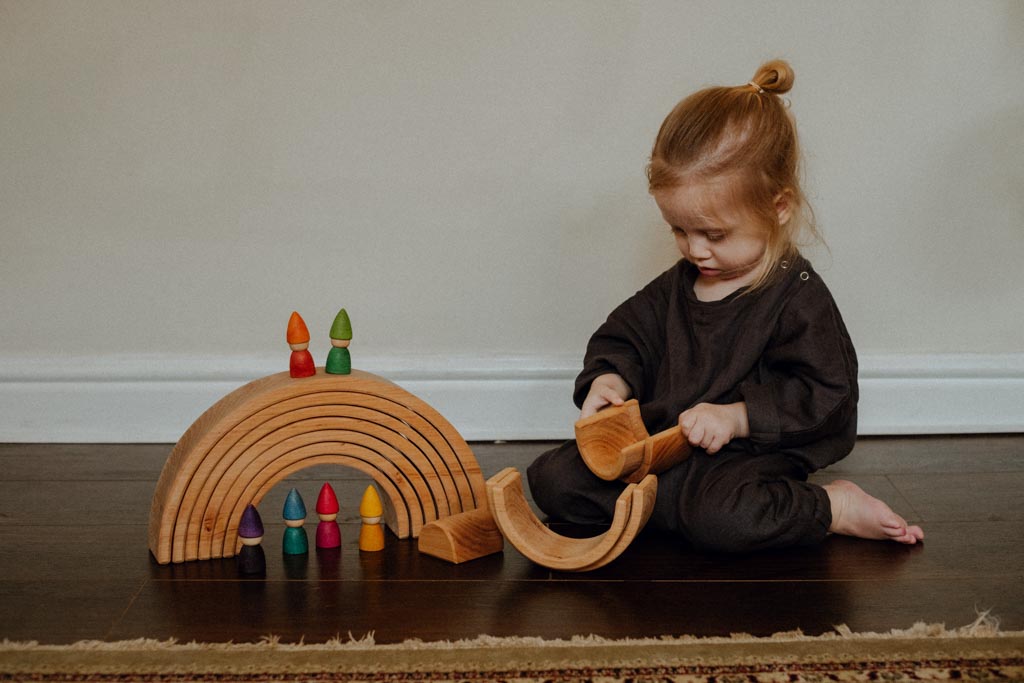
The Grimm’s Rainbow takes this learning and extends it. Going in, coming out, going through. The rainbow is a tunnel that you can elongate by adding further pieces.
The train disappears inside.
By now we know that it continues to exist. But where is it? How long will it take to come out at the other end? Could there be a mishap along the way? Understanding the enveloping schema is the work of many years.
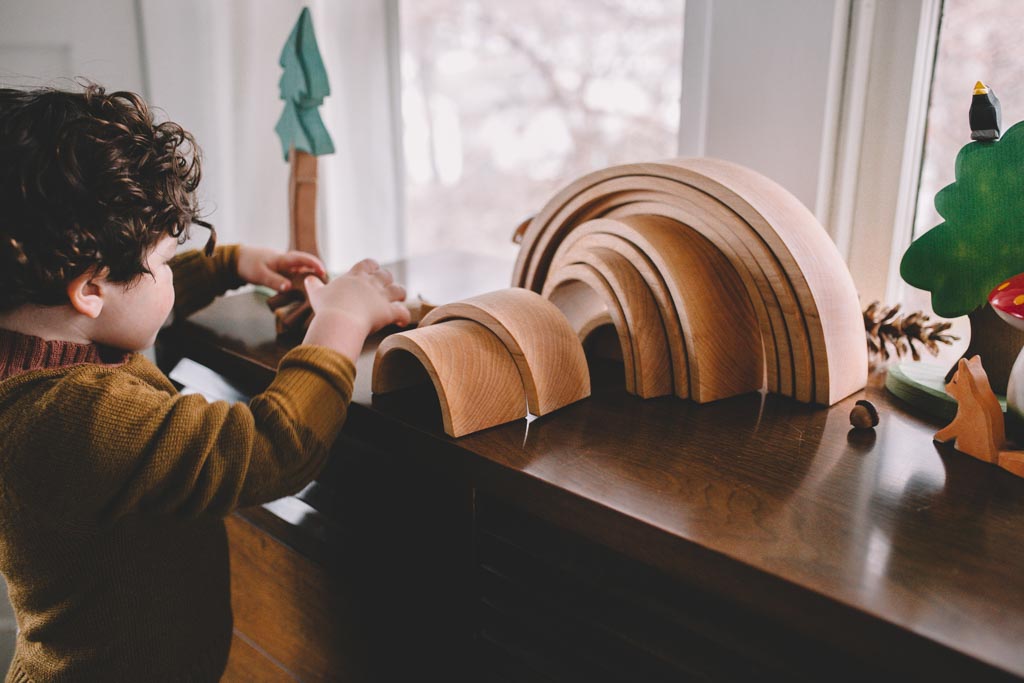
Read more about schemas and wooden train sets.
Enclosures
Put two Grimm’s rainbow arches together and you have an enclosure. What will you make? A desert island? A pen for your livestock? A maze for your unicorn?
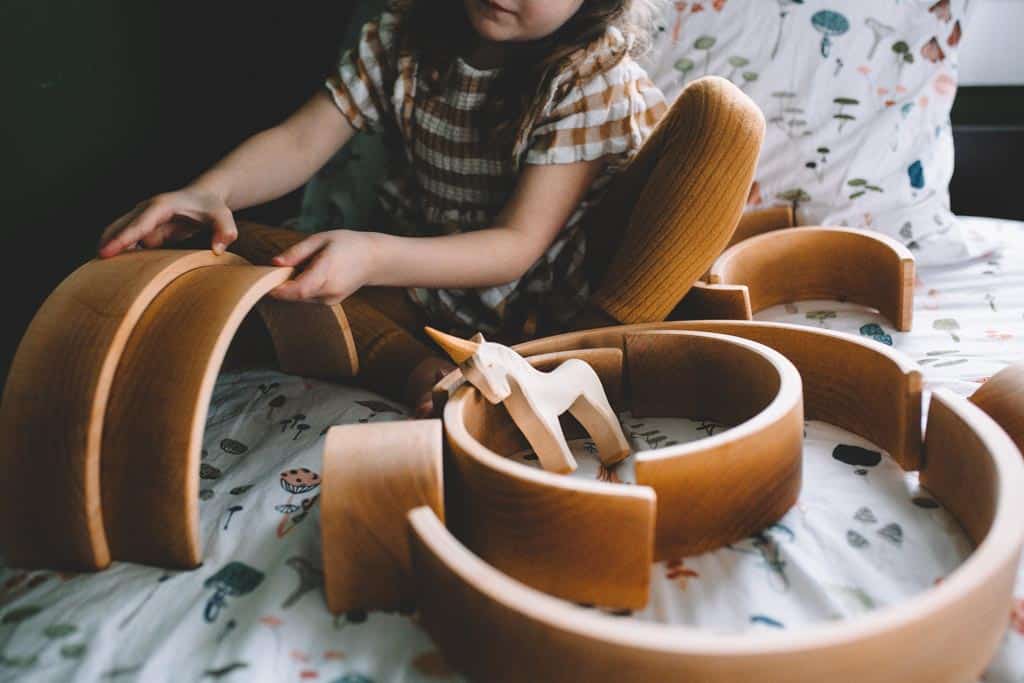
Enclosing is another type of schema. It is the idea that space can be contained. Its counterparts are going in, coming out and crossing a boundary.
In preschoolers, enclosures become the head of a stick man and the circle in letters and numbers like ‘o’, ‘p’, ‘Q’ and ‘9’.
You can’t learn the alphabet until you have made an enclosure with your hands.
Even a single arch can be an enclosure. The circle needn’t be complete. What’s important is that there is that there is an ‘inside’ and an ‘outside’.
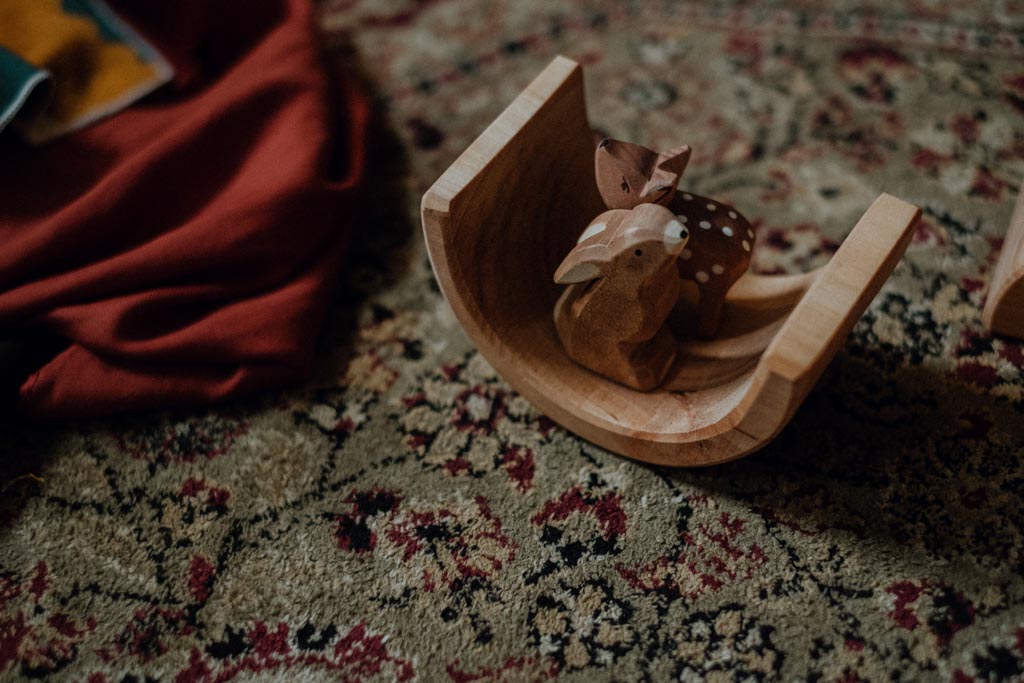
Note: You can do something similar with the Grimm’s Rainbow Bridge, a flatter, 5-piece version of the original.
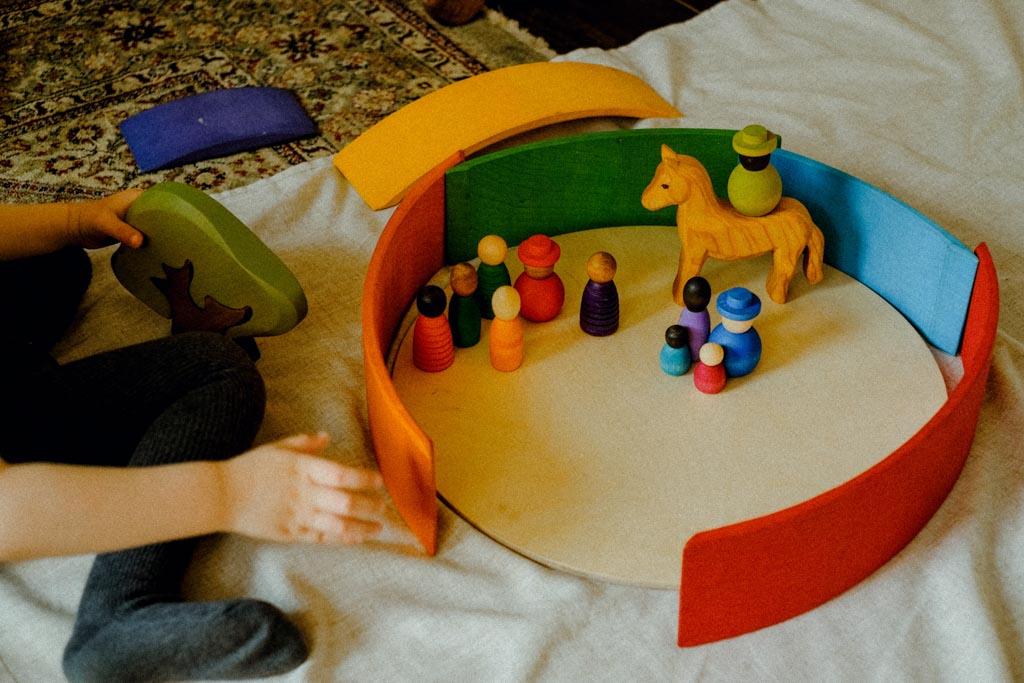
Stunt building
There’s a particular kind of block play called stunt building.
Once a child understands a toy’s properties, the next step is to push the boundaries to see what’s possible. How high can I go? Can I build with an upside-down arch at the bottom, creating a kind of see-saw? What’s the widest span I can make before it collapses?
This is one of the Grimm’s rainbow’s secrets, something your toddler is yet to discover. By the time she reaches preschool, however, she is ready to experiment.
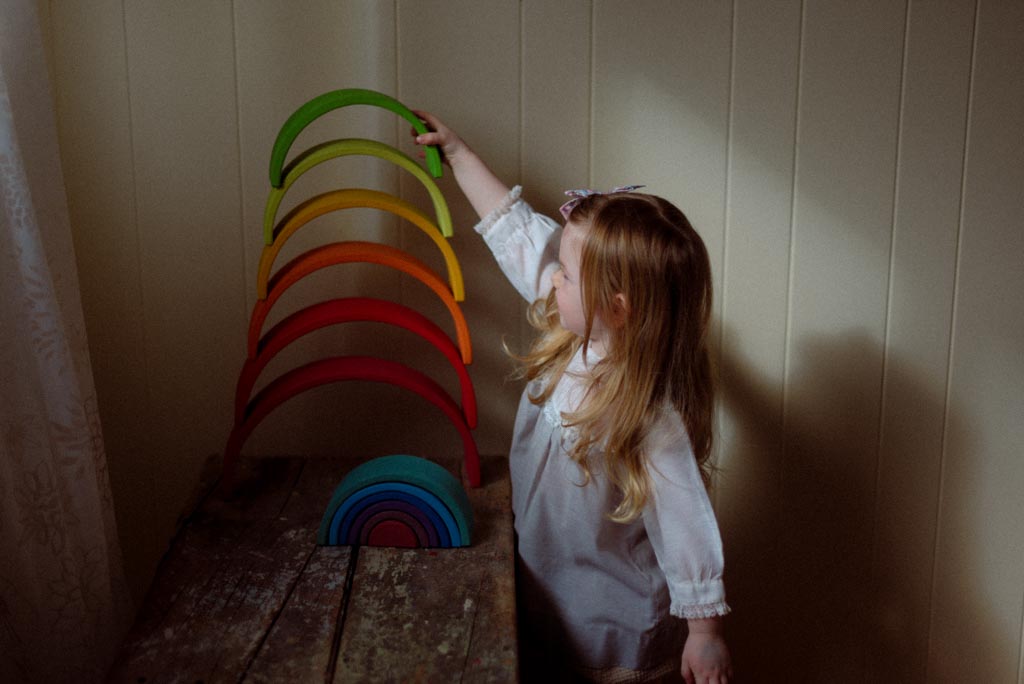
Rainbows for small world play
Now that we know the value of tunnels and enclosures, the play potential of Grimm’s Rainbows for small world play becomes clear. The characters in our story have something to do.
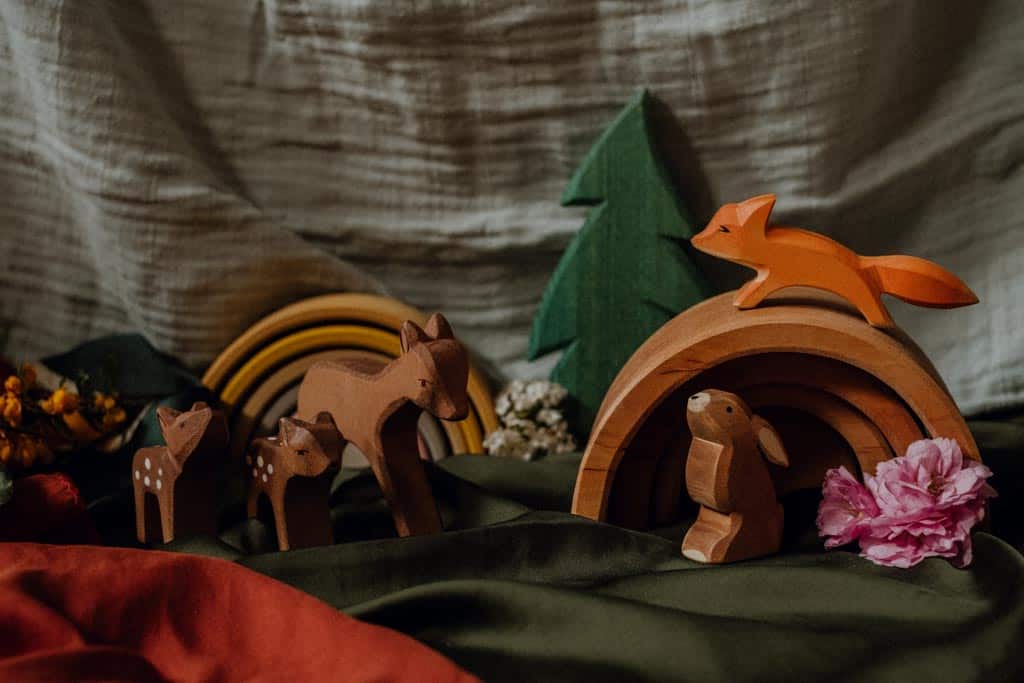
Make hills for the rabbits of Watership Down; make a bridge for the three billy goats – and the troll!
You can get as creative as you like.
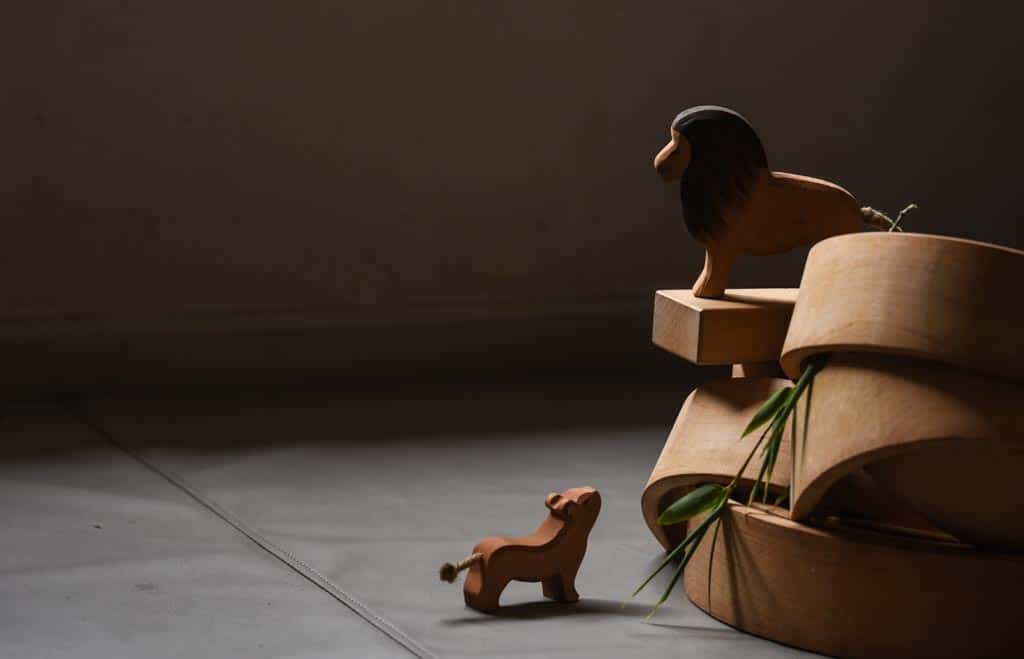
Mix with a set of Grimm’s blocks to increase the possibilities. You don’t need many.
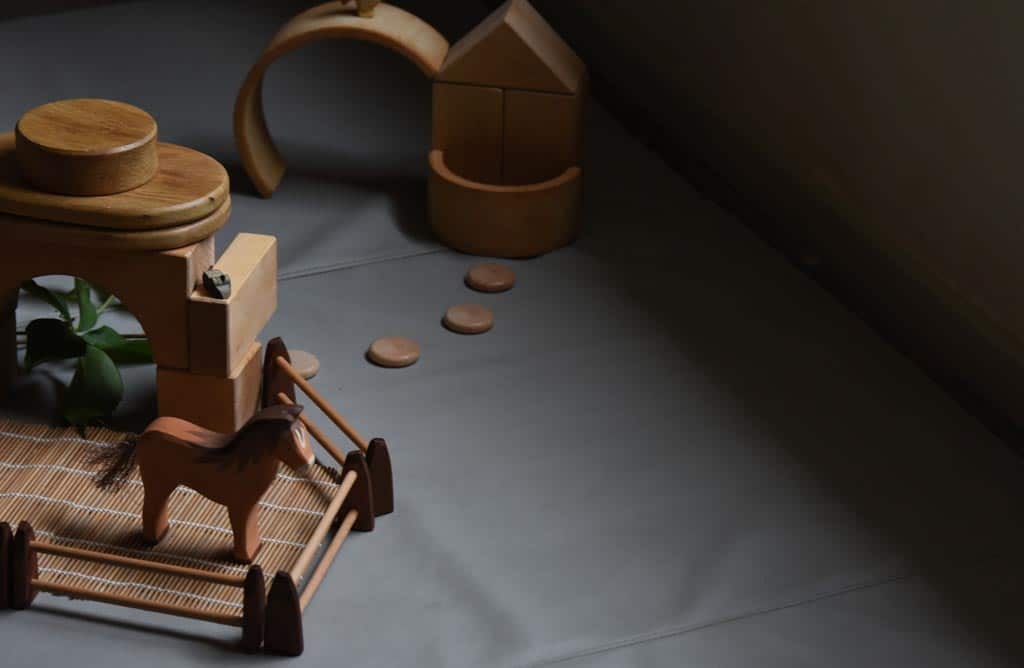
Which rainbow should I choose?
There are two variables – colour and size.
Colour
Grimm’s Rainbows come in five colour combinations:
- Rainbow
- Pastel
- Counting
- Natural
- Monochrome
If you don’t mind mixing and matching, choosing a colour is easy. But if you want everything to match, take a look at the following table
| Rainbow | Friends | Semicircles | Other |
|---|---|---|---|
| Rainbow | Rainbow Friends | Rainbow Semicircles | Rainbow Building Boards |
| Pastel | Pastel Friends | Pastel Semicircles | Pastel Building Boards |
| Counting | N/A | N/A | Building Set Numbers, Colourful Bead Stair, Stepped Counting blocks |
| Natural | N/A | Natural Semicircles | Natural Building Boards |
| Monochrome | N/A | N/A | Monochrome Building Boards |
If you go for ‘Counting’, Natural or Monochrome Rainbows, note the lack of matching peg people. Devotees of the maths resources, like the Stepped Counting Blocks and Building Set Numbers should choose the Counting Rainbow.
Grimm’s Rainbow dimensions
Confusingly, the Grimm’s Rainbow is not the Grimm’s Rainbow. That honour belongs to the large, 12-piece version. The former is the 6-piece, medium-sized offering.
The newer, ‘counting’ rainbow has 10 arches, so that each colour corresponds to its counterpart in the Grimm’s ‘World of Numbers’ range (see table above).
| Name | Width (cm) | Pieces |
|---|---|---|
| Large | 38 | 12 |
| Counting | 27.5 | 10 |
| Medium | 17 | 6 |
| Mini | 10.5 | 6 |
Here is the mini rainbow, alongside a Maileg mouse for comparison.
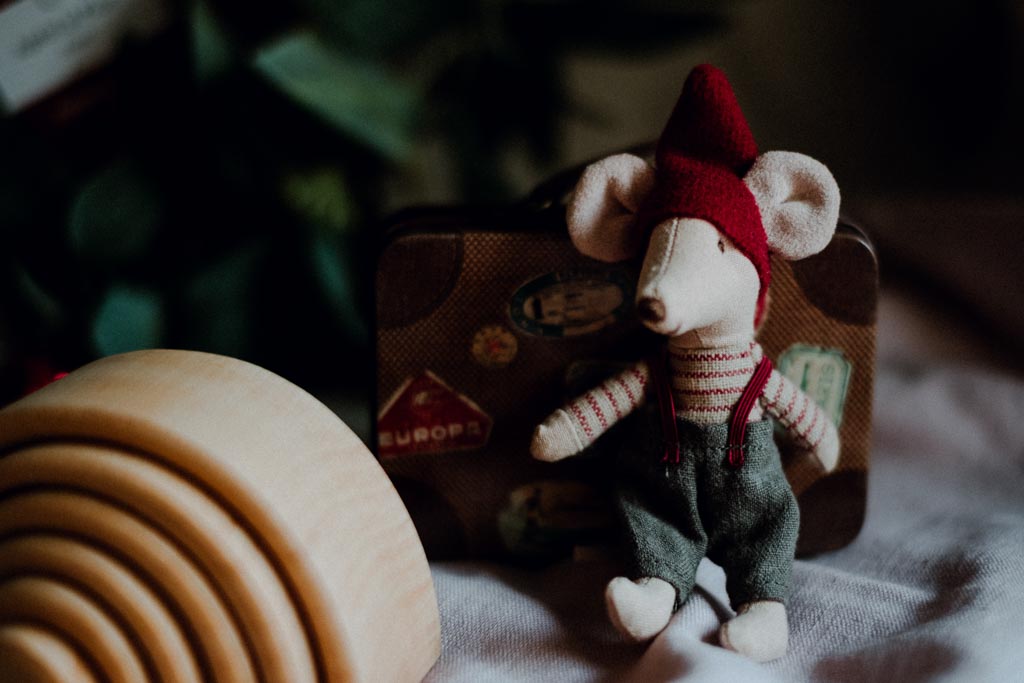
Why is Grimm’s wood rough?
First is what Grimm’s call the ‘velvety rough’ surface. The lime wood used to make their toys is perfect for absorbing dye but it doesn’t give the smooth finish of finely-sanded beech. When stunt building, this can be an advantage as the extra friction makes constructions more stable. Your towers can be taller and more daring.
The wood can be knotty
Secondly, Grimm’s rainbows often contain imperfections. This can be frustrating if you expected fully saturated colour. A knot marks the point on the trunk where a branch once was. It tells the story of the tree. By using such wood, Grimm’s say that they are letting the wood speak, celebrating its blemishes and uniqueness.
Poetic language aside, if a uniform finish is non-negotiable, consider a painted rainbow like this one from My Little Dutch. But remember, painted wood slips more easily and is harder to build with. Fine for tunnels, less so for towers.
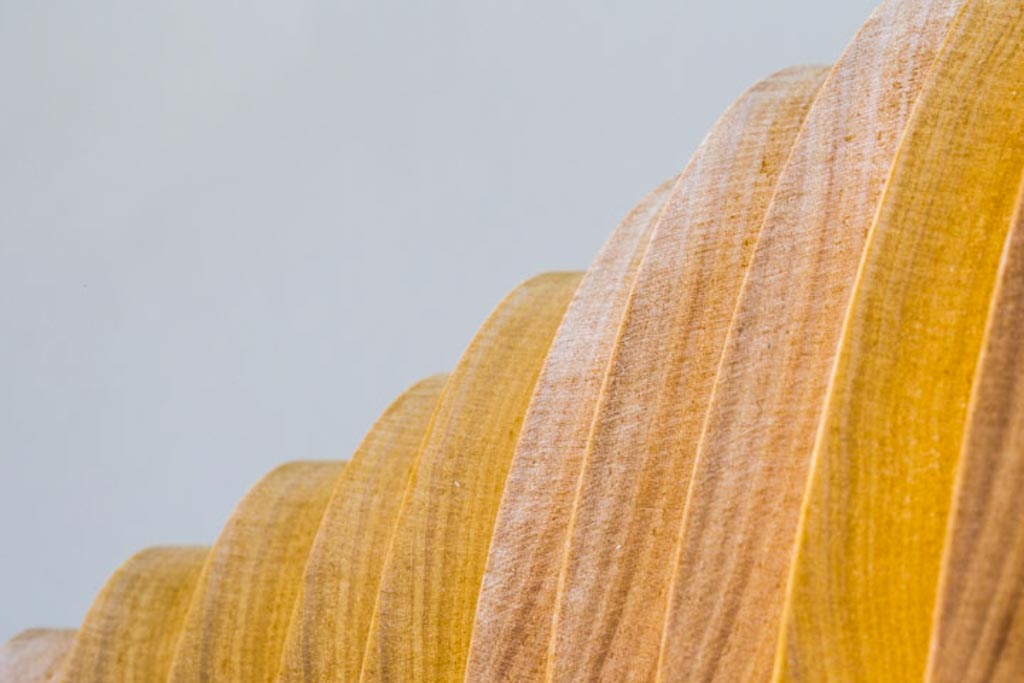
Grimm’s Large Rainbow
This is the ‘classic: 12 pieces’. All the colours of the rainbow, and five more thrown in for good measure.
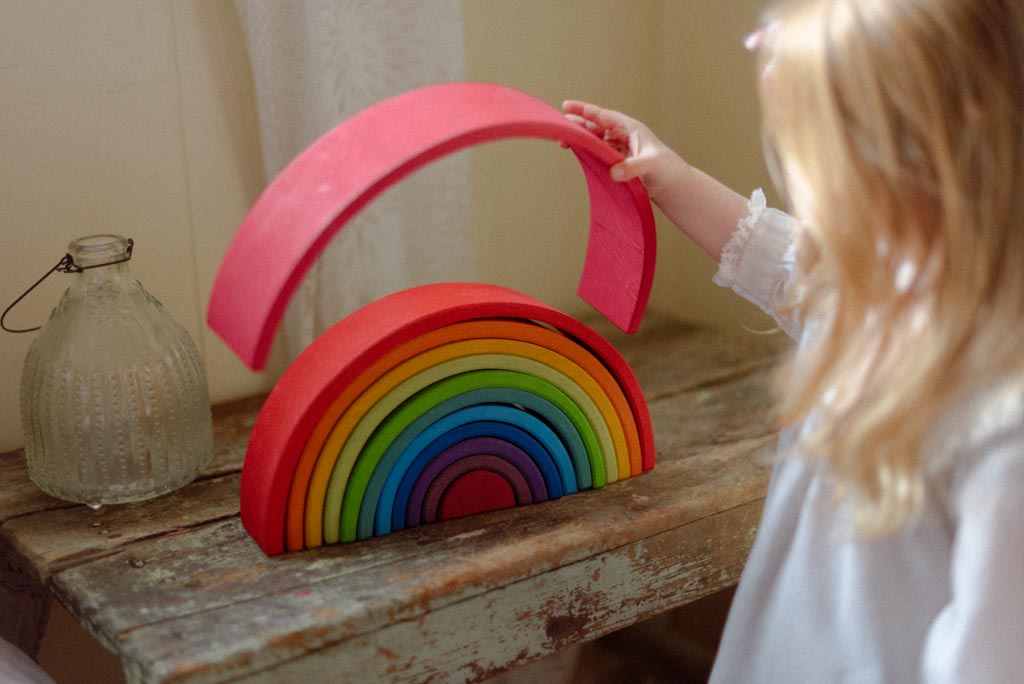
If you want to create stacking towers, choose matching semicircles:
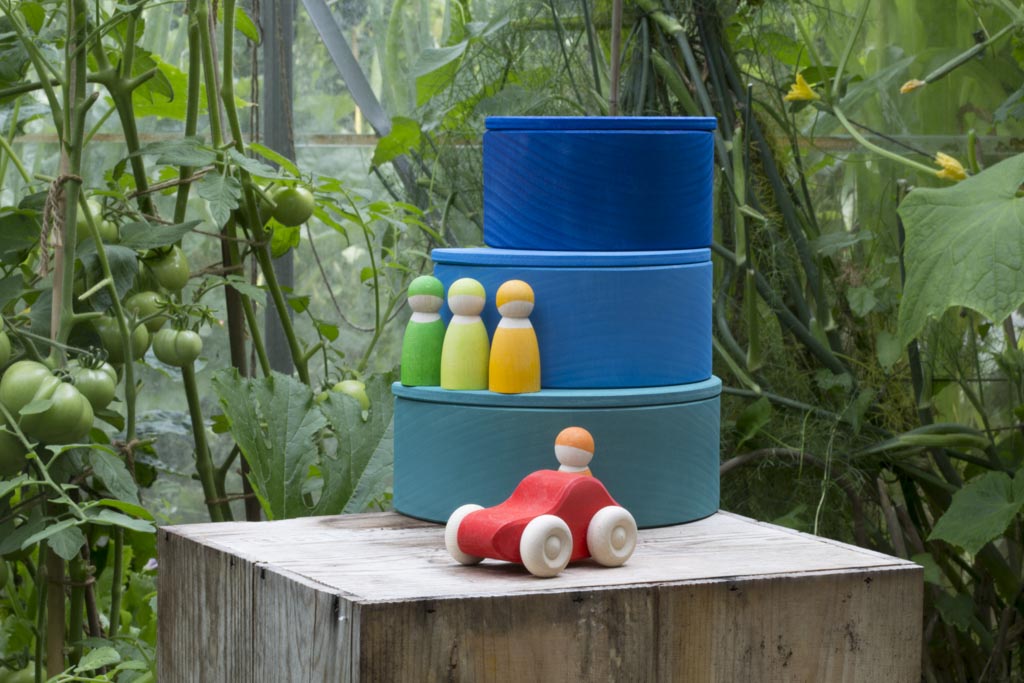
And the corresponding rainbow friends:
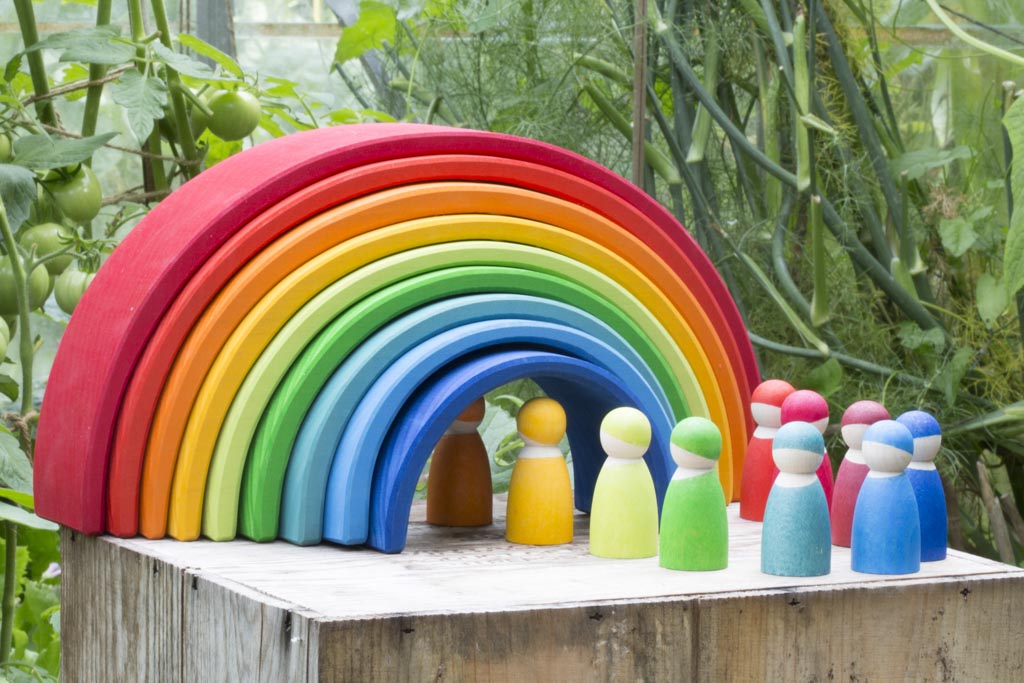
Grimm’s Natural Rainbow
Natural wood is beautiful but the imperfections are more noticeable.
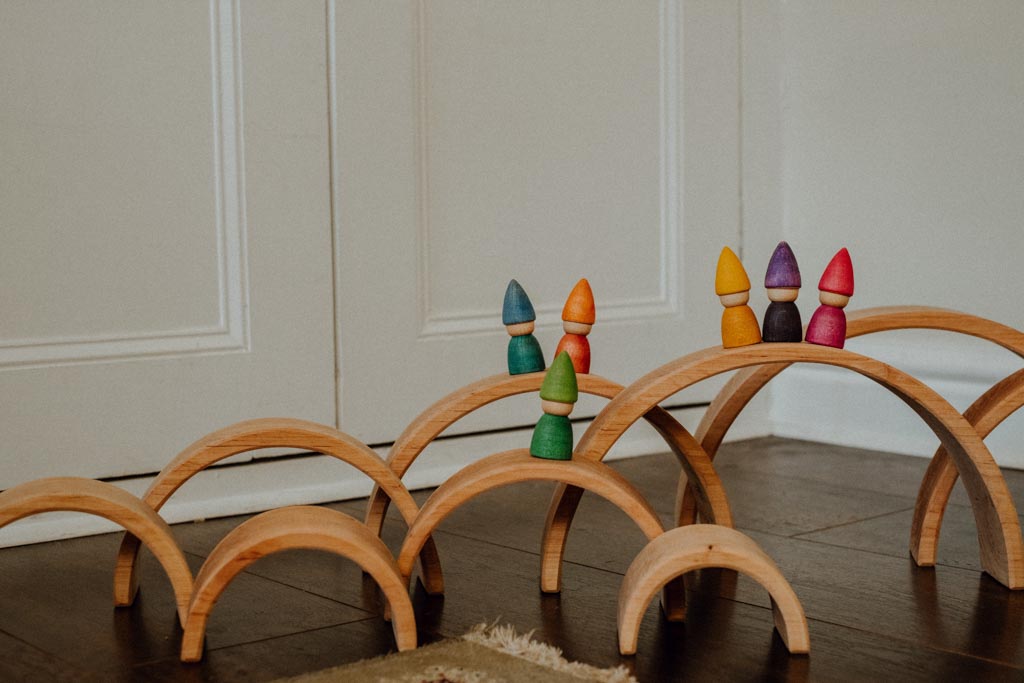
In the 100 Toys house we preferred a natural finish to our rainbows and blocks.
Here’s an old photo of some now-discontinued Grimm’s toys from my own children’s collection:
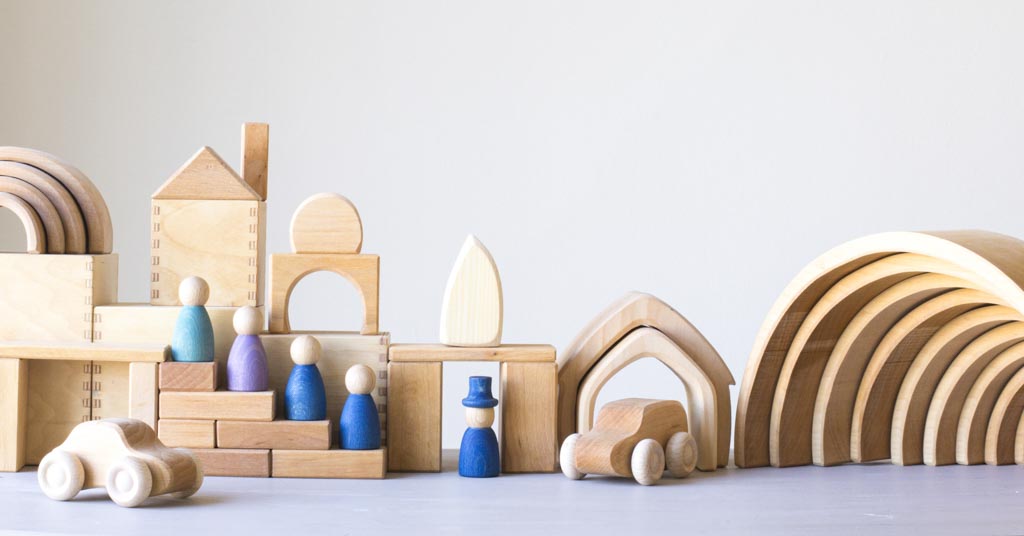
The plain wood provides a blank canvas upon which to paint your small world scene. The figures stand out. They are more clearly central to the story.
But what do I know? The rainbow version out-sells the natural by ten to one.
Grimm’s Rainbow (6 Pieces)
The ‘medium-sized rainbow’. The perfect first rainbow for a toddler. Good for nesting and stacking but perhaps too small to make more than rudimentary tunnels. The pieces match the six innermost arches of the classic rainbow.
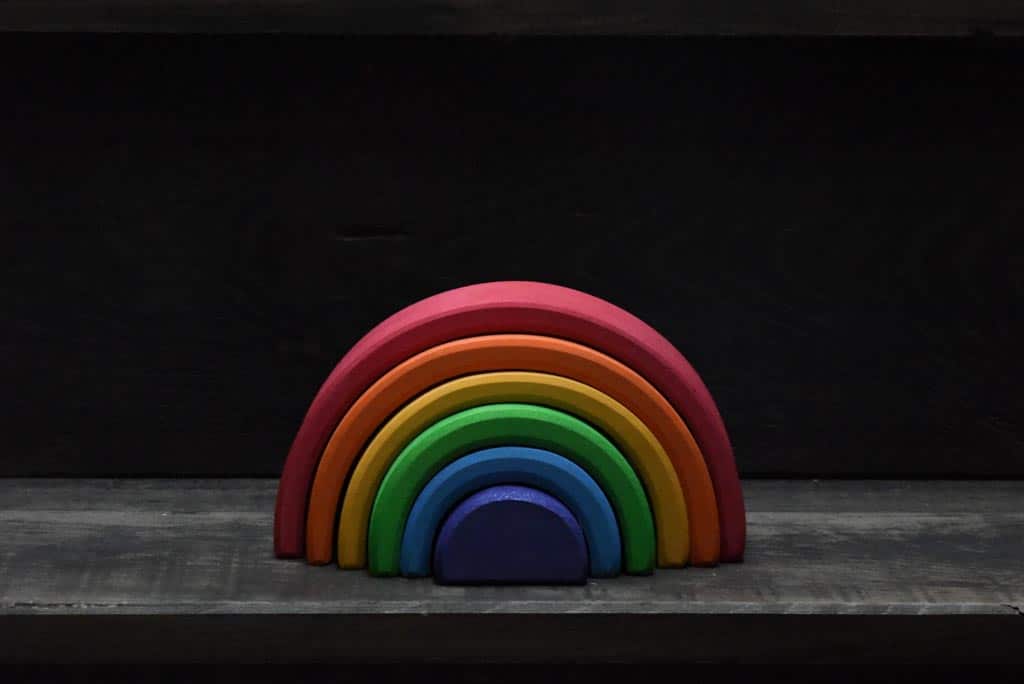
Grimm’s Pastel Rainbow
The Pastel Rainbow is more muted but in all other ways the same as the classic.
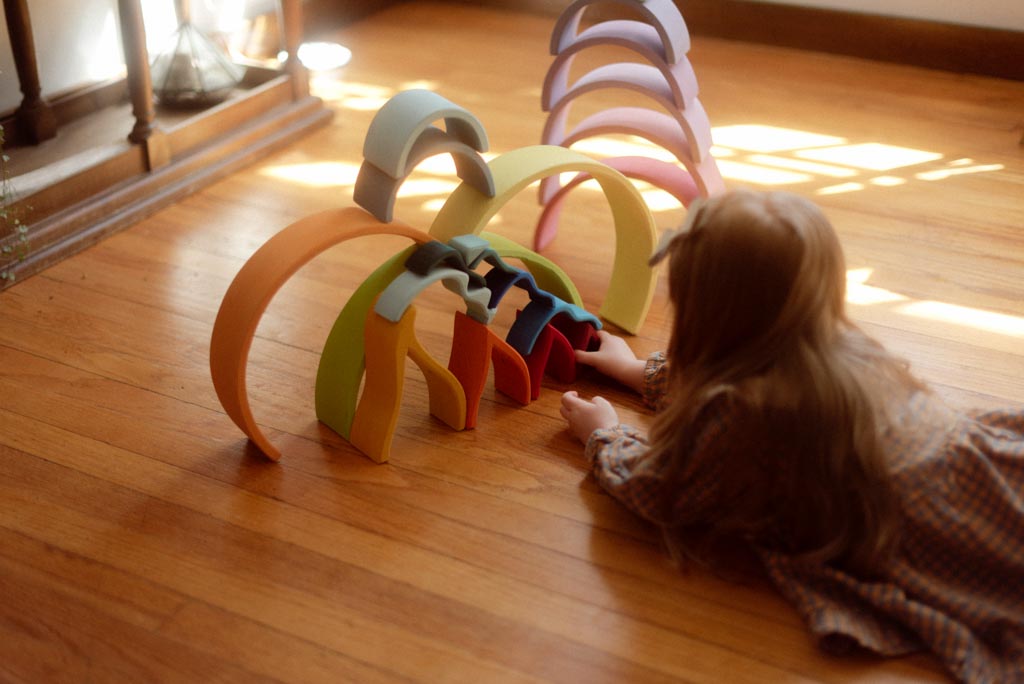
Grimm’s Mini Rainbow
The Mini Rainbow is pocket-sized fun that’s great for construction and small world play on the go. Not big enough for Rainbow Friends or trains to go through but you can make brilliant games with a solitary marble and bit of imagination.
Here pictured next to a Maileg mouse. Only 10.5 cm across.

Grimm’s Counting Rainbow
With 10 arches rather than 12, this slightly smaller stacker has arches that match Grimm’s ‘number’ toys. The 10th arch is blue, like Number 10 in the Building Set Numbers, the first is turquoise, like Number 1.
See the Counting Rainbow.
Grimm’s Elements
The Grimm’s ‘elements’ – fire, water and earth have much the same play value as the rainbow. They are nested, so seriation is built in, and they all function as tunnels and stackers for children enjoying schema play.
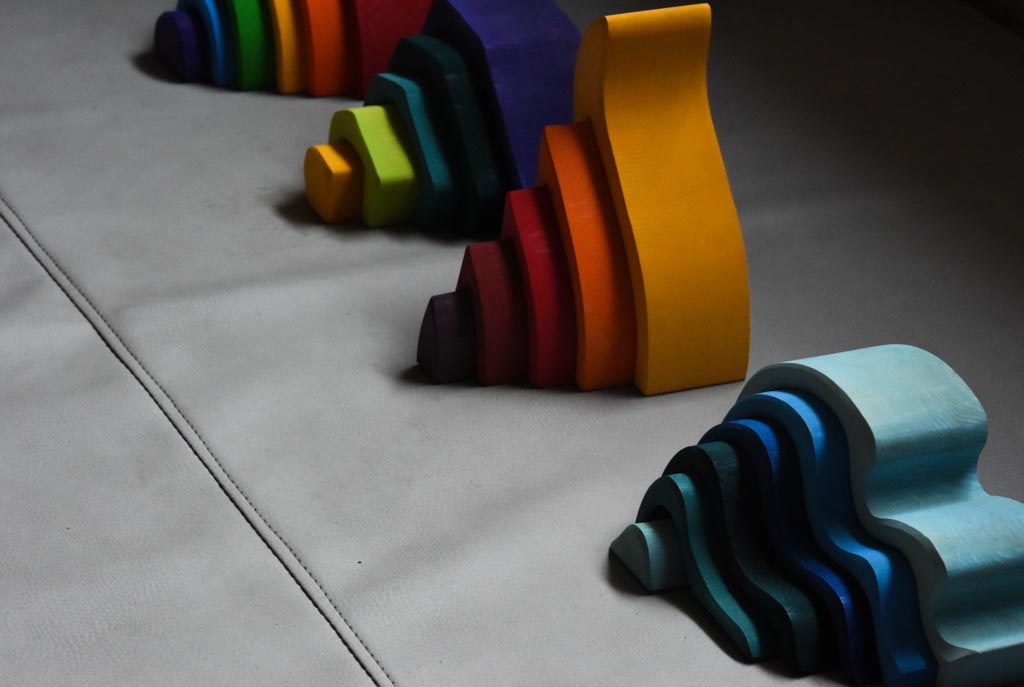
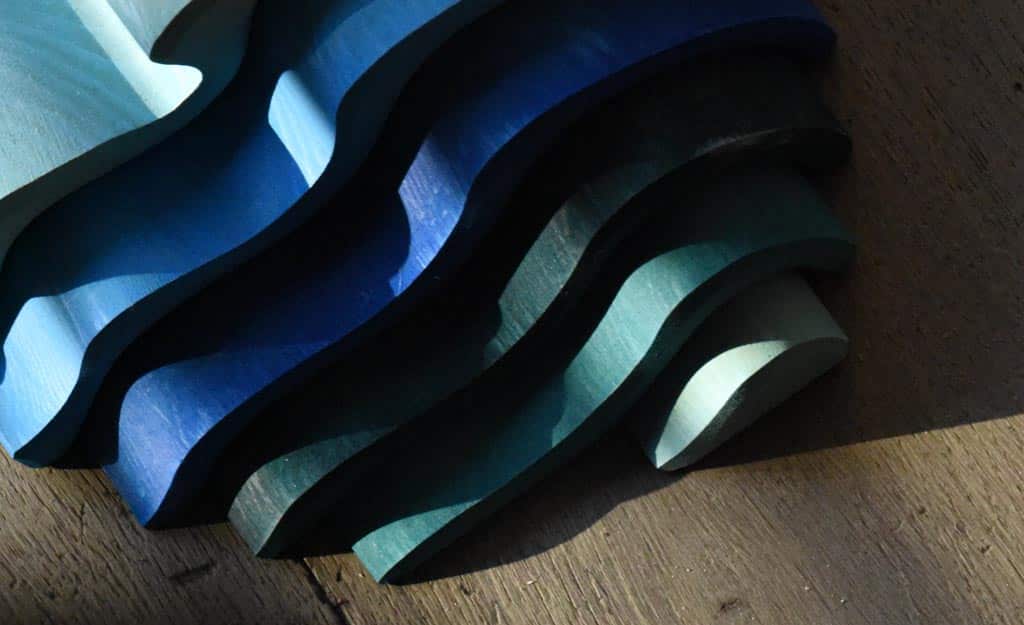
Grimm’s rainbow alternatives
Gluckskafer Sunrise and Sunset
Once upon a time, Grimm’s and Gluckskafer were one company. Following the parting of ways, Gluckskafer continued to make toys in the same way, which is why their products all have that special Grimm’s feel.
For a slight twist on the rainbow, consider Sunrise or Sunset.
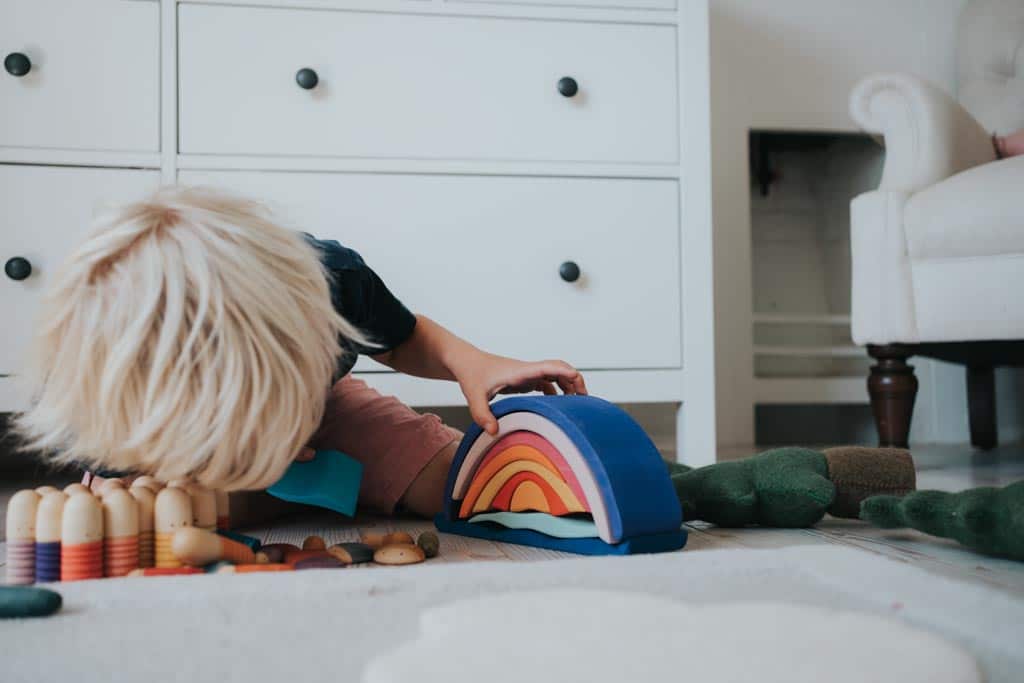
Pots, pans and bowls
You can learn seriation from almost anything. I bet you didn’t have a Grimm’s rainbow when you were a child. But you discovered how to put things in order all the same. That’s because everyday life is packed full of interesting challenges.
A set of bowls, pots and pans, plastic yoghurt pots – DIY nested toys are everywhere.
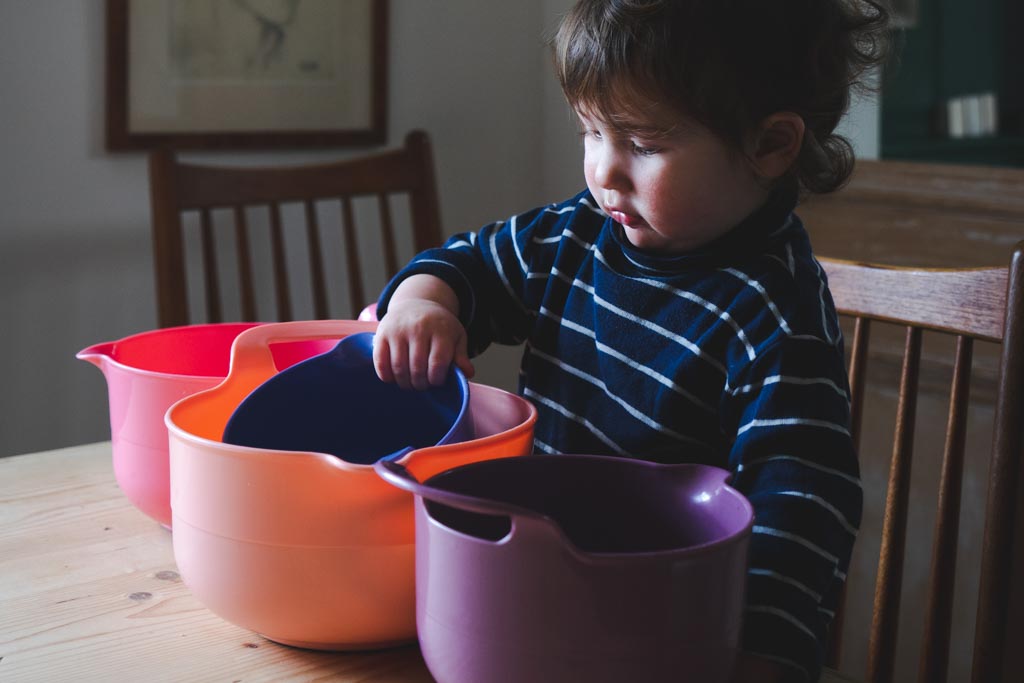
Where toys win is that you can keep them in the playroom. Daddy doesn’t have to take your plaything in order to cook dinner. And they are clean, beautiful and safety tested.
Is a Grimm’s rainbow worth it?
There’s nothing quite like a Grimm’s Rainbow. The look and feel is unique. They also last a long time and you’ll get a huge amount of play value out of them. But if your budget doesn’t stretch that far, a cheap, painted rainbow offers the same learning potential.
Of course, Grimm’s toys are designed to work in harmony with each other. If you plan to get semicircles, friends and blocks, you can really extend the learning.
But, as we have seen, a few items from the kitchen cupboard and, perhaps, some Cuisenaire rods (as recommended in our preschooler course, Get Set Five, work just as well.
In the end, it’s an aesthetic choice.
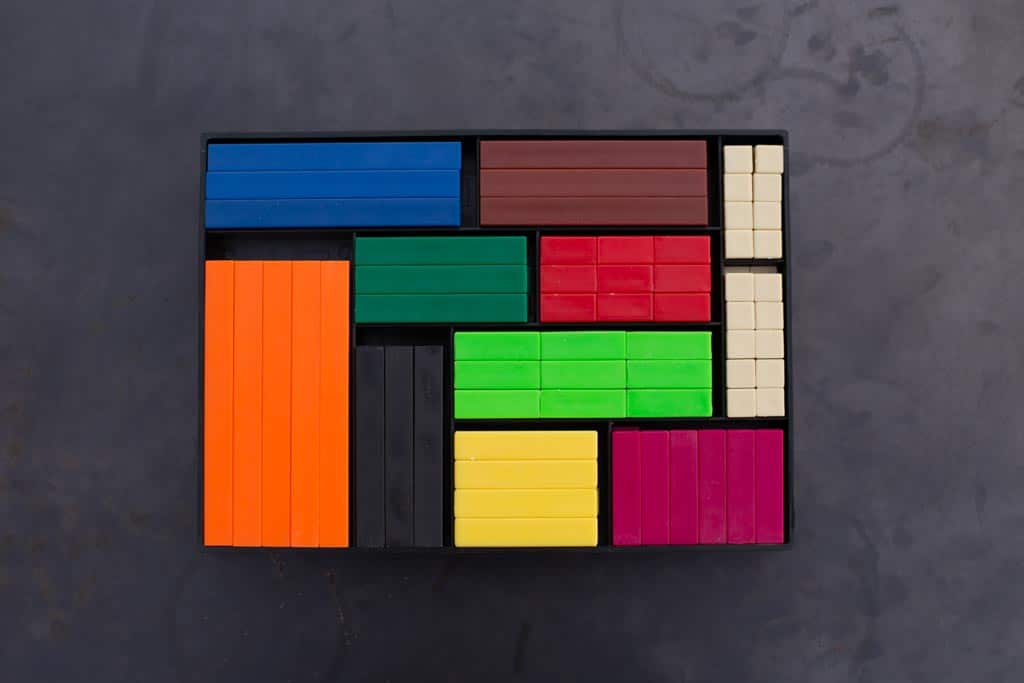
Final word
In a roundabout way, via wooden train sets, object permanence and pots and pans, we have come to a review of the Grimm’s Rainbow.
It’s a special toy because it is so open-ended. Babies and toddlers love the heuristic aspect – the exploration and discovery of the tunnels’ secrets. But preschoolers love them too for the small world and stunt-building possibilities.
FREE module!
Interested in learning more about how to get more fun from fewer toys? Would you like to offer your child interesting independent play activities that naturally help build the skills they need for school and for life? Our courses for toddlers and preschoolers, A Year With My Child and Get Set Five might be right for you. Try a module for FREE.

